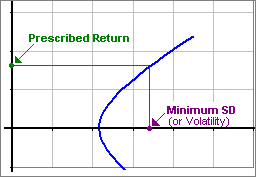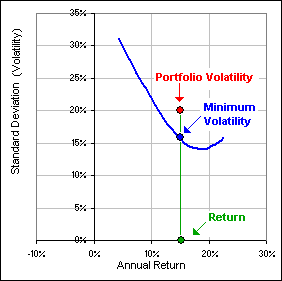| reSampled Frontier ... and portfolio allocation |
| an Old Frontier |
Once upon a time (1952) Markowitz introduced Modern Portfolio Theory and the so-called
Efficient Frontier.
(He shared a Nobel prize for this work.)
>Efficient frontier? Huh?
That Efficient Frontier stuff goes like this:
Our portfolio contains N assets, with Mean Returns r1, r2, ...
We allocate fractions of our portolio to these N assets and we want to select
these fractions, namely x1, x2, ... so that:
- x1 + x2 + ... + xN = 1
The fractions add to "1" since 100% of our portfolio is devoted to these N components
- The Volatility (or Standard Deviation) of your portfolio, SD is prescribed
That is, pick your volatility tolerance (according to your genetic makeup)!
The Volatility is sometimes called "Risk" (for no logical reason) ... so you're picking your Risk level.
This Volatility (or Standard Deviation) will depend upon the returns of the N assets as well as your allocations x1, x2 etc. - Determine the allocations so that your Average (or "expected") Return, namely R = x1r1 + x2r2 + ... + xNrN, is a maximum.
>And how do you do all that?
You pick a set of fractions devoted to the N assets ...
>You pick x1, x2 etc.?
Yes, then you see what R-value that gives.
Then you pick another set of x's ...
>Which add up to 1, right?
Yes. That's #1, above. For example, you might have x1=0.60 and x2=0.25 and x3=0.15
meaning (for three assets) 60% + 25% + 15%.
Anyway, you see what R you get. Then you pick another ...
>Again and again until you get the largest R? That's a lot of work, eh?
|
A computer can do all the work, but I don't want to talk about the Efficient Frontier.
Instead, I want to ... >Wait! What's that frontier look like? The typical picture assocated with the Frontier is shown here 
along with a selected Standard Deviation and the maximum R-value. You can see the relationship to the Sharpe Ratio.
| 
|
>Then we can relax, eh?
Yes ... and that ain't good!
|
Note that you could also prescribe the Return you'd like (that's R) and vary the allocations until you get the minimum SD.
Or, you could just find the point which gives the minimum ... uh, "Risk".
One problem with this stuff (besides the fact that we rely heavily upon historical data) is that the
Frontier moves about when we make small changes to the data.
| 
|
>So what do you intend to do?
Talk about a sampled Frontier
... or, better, a reSampled Frontier 
>Beg pardon?
It's an idea promoted by Michaud (1989) and Jorian (1992).
| a New Frontier |
Here's a way to introduce some randomness into future values:
>And the variation in associated allocations, eh?
| 
|
Taking a set of historical returns and sampling from that set (again and again) is a neat way to get randomness from a fixed set of returns.
You never have to worry about assuming some kind of distribution (normal? lognormal?) or "fat tails".
I used it myself, in sensible withdrawals
To see the effect of changing the returns (for four assets with prescribed Means and Volatilities),
you can try this neat spreadsheet by Michael Kishinevsky.
- Click here.
- Select four (monthly) Means and Standard Deviations and an (annualized) Risk-free Rate.
- Press F9 to get a bunch of random returns for each asset (selected from four normal distributions with the prescribed Means and SDs).
- Look affectionately at the Efficient Frontier.
- Repeat step 3 (and 4).
|
We noted above that one can prescribe the Return and get the minimum Volatility (for that Return)
... hence an Efficient Frontier as in Figure 1A. However, we can also plot the Volatility against the return, like Figure 1B (which is easier to interpret )
>Did you say that one can prescribe the Return? Can I ask for 100%? Can I ask for ...?
|  Figure 1A
|
For just three assets you can try this spreadsheet:
Click here to try it out, or
RIGHT-click on the picture and Save Target to download a copy.
>How do I get a feel for what the appropriate allocations might be?
Or how that allocation might change as the returns are reSampled?
Or if I start with different assets and different returns ... or?
Yes, well ... you might want to play the FRONTIER GAME

>A game? How useful is that?
On a scale from 1 to 10, it's a 3, alongside Solitaire
... but it does illustrate the effect of reSampling the same set of returns
and how the "optimal" allocation can change quite dramatically.
Some References:
newfrontieradvisors.com in PDF format
cornell.edu in PDF format
a book by Michaud on Efficient Asset Management
Stuff from Invesco in PDF format



